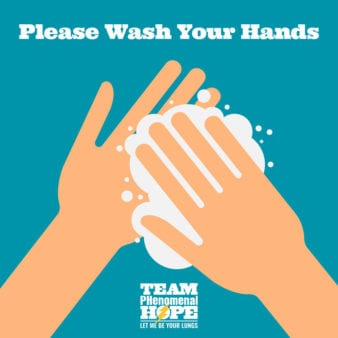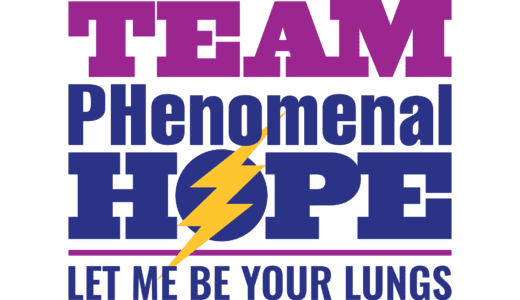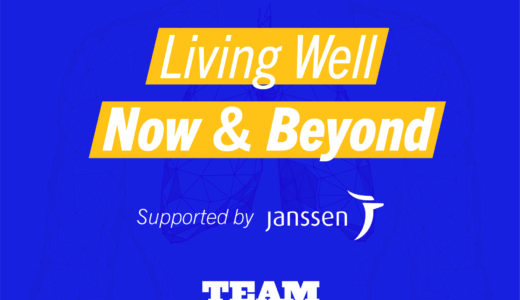Responding as a Community and Country to COVID-19

A message from Patricia George MD, President, Team PHenomenal Hope
Dear Teammates, Friends, and PHriends,
We find ourselves in challenging times. As we learn more and more about the coronavirus and see the outbreak grow in our country and our communities, with schools being closed, employees being encouraged to work from home, towns and cities encouraging social distancing, and sheltering in place, what do we do in challenging times like this?
As a pulmonary hypertension physician and global citizen, deluged with information and misinformation coming from so many sources, and admittedly having my own anxiety about what our city and country will face in the coming weeks, this is a question I have been asking myself.
And here are the answers I’ve come up with so far (my own personal survival guide):
1. What is COVID-19 and what does flattening the curve mean and why is it important?
COVID-19 is the disease caused by the new coronavirus that emerged in December 2019. This new coronavirus is spread from person to person, and is diagnosed with a laboratory test. COVID-19 symptoms include fever, cough, and shortness of breath. It can be severe, and some cases have caused death. People who are older and have underlying chronic medical conditions are at greater risk of death.
The Coronavirus outbreak is serious, and one of the greatest challenges of our generation. The challenge for us it the rapidity of the spread can be so accelerated, that it potentially will lead to exhausting our resources (hospital beds, ventilators, gowns and masks that protect the healthcare workers). The goal of social distancing is to slow down transmission, flatten the curve in terms of increase in numbers of cases, so that we are able to deal with the cases as they arise. For a good model of what this means, check out this Washington Post article with video from March 14.
2. Follow the guidelines from the Centers for Disease Control (CDC) and local government health officials to protect yourself and others.
If you do nothing else, follow the recommendations from the CDC and your local government health officials. The current CDC recommendations to protect yourself and others are by avoiding being exposed to the virus. Their recommendations are below, and in more detail on the CDC website.
The virus is spread from person-to-person, from respiratory droplets, so you can minimize exposure by:
You can also help protect others by doing the following:
3. What if I am sick?
4. What about my pulmonary hypertension?
It is important during this time to stay in contact with your PH care team. Each institution is taking measures to protect their patients. Many have moved to telehealth for visits, and each institution is approaching this outbreak with measures to make their institution as safe as possible, not only to meet the needs of patients sick with Coronavirus, but to also make sure we protect our patients and staff and continue to take care of people with non-viral medical issues. Every area is different, and clinics are evolving daily as the outbreak evolves, it is important to reach out to your PH care team with any questions, and ask them about local procedures.
Please also make sure you keep your cell phone charged and respond to calls from your PH team. And when you leave messages, given the increase in phone calls, please leave a detailed message to help the staff answer them by level of importance. Rather than saying “This is Mrs. Smith. Please call me back,” consider calling and saying “This is Mrs. Smith and I have a question about my appointment timing on Friday,” for example.
5. Stay up to date and utilize reliable sources for information. And be careful about spreading misleading information.
For the most reliable and updated information on COVID-19, I recommend the following:
Check out the CDC and World Health Organization (WHO) for the latest information.
The latest data on COVID-19 cases can be found at Johns Hopkins here.
A special comment regarding your daily news sources. This pandemic has been made more dangerous by hyper-partisan news sources who, especially at the beginning of the outbreak, spread lies that this was a hoax and downplayed the severity of this situation. This is a good time to pull toward neutral sources or ones with minimal bias that work to disseminate facts. Look to this Media Bias Chart at Ad Fontes Media here.
6. While we are all asked to maintain social distancing, engage in Pro-Social behavior.
Social distancing does not need to mean completely isolating. You can keep your distance but still meet using the phone, FaceTime, VideoChats, Zoom meetings for work. If you’re going to the store, consider picking up food for an at-risk neighbor. If you’re at risk, ask your neighbor or friend to pick up food for you from the store. Buy gift cards from local businesses. Try to purchase directly from local businesses or make a donation to your zoo, food bank, museum, or charity of choice to help keep everyone afloat. If you are healthy and able, consider donating blood (call your local blood bank/Red Cross).
7. Engage in activities that nourish your own soul.
In addition to Pro-Social behavior, many of us have other activities that help calm our minds and heal our souls. Engage in what sustains you: whether it is prayer, meditation, a solo walk or bike ride outside in the park or a solo hike on the trail. Make sure you are getting good nutrition and adequate sleep. Take care of yourself. If you suffer from anxiety, depression or any mental health issues, reach out to your therapist/counselor, psychiatrist, or mental health helplines, as the stress of this situation could worsen those issues.
Friends and PHriends, although we stand 6 feet apart, we will get through this together, and face this challenge bravely. By social distancing to protect ourselves and others, engaging in Pro-Social behavior we can still support one another through this crisis, we will meet this global human challenge together.
Peace, love, and bikes,
Patricia George MD



